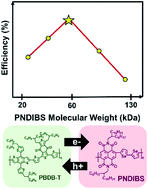Elucidating the impact of molecular weight on morphology, charge transport, photophysics and performance of all-polymer solar cells†
Abstract
Understanding the influence of polymer molecular weight on the morphology, photophysics, and photovoltaic properties of polymer solar cells is central to further advances in the design, processing, performance and optimization of the materials and devices for large scale applications. We have synthesized six number-average molecular weight (Mn) values (21–127 kDa) of biselenophene–naphthalenediimide copolymer (PNDIBS) via direct heteroarylation polymerization and used them to investigate the effects of the acceptor polymer molecular weight on the charge transport, blend photophysics, blend morphology, and photovoltaic properties of all-polymer solar cells (all-PSCs) based on PNDIBS and the donor polymer PBDB-T. The short-circuit current and power conversion efficiency (PCE) of the PBDB-T:PNDIBS blend devices were found to increase with increasing Mn until reaching peaks at an optimal molecular weight of 55 kDa and then decreased with further increases in Mn. The maximum PCE of 10.2% observed at the optimal Mn value of 55 kDa coincided with optimal blend charge transport properties, blend photophysics, and blend morphology at this critical molecular weight. Compared to the bi-continuous network of ∼5.5–6.5 nm crystalline domains with predominantly face-on molecular orientations observed at 55 kDa, a relatively disordered microstructure with larger scale phase separation was evident at higher Mn while more finely packed crystalline domains were seen at 21 kDa. The sensitivity of the device efficiency to the active layer thickness was found to also depend on the PNDIBSMn value. These results highlight the importance of tuning the molecular weight of the polymer components to optimize the morphology, charge transport, photophysics and efficiency of all-polymer solar cells. The results also provide new insights on structure–property relationships for a promising n-type semiconducting copolymer.

- This article is part of the themed collection: Celebrating our 2025 Prizewinners


 Please wait while we load your content...
Please wait while we load your content...